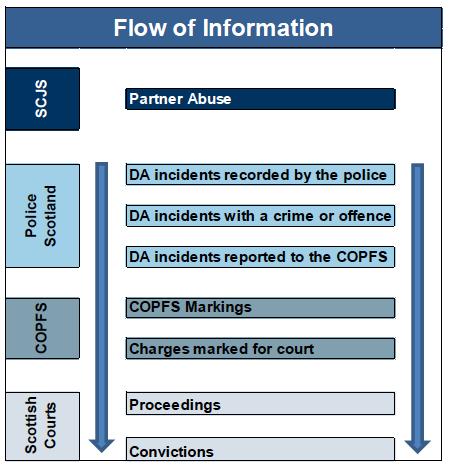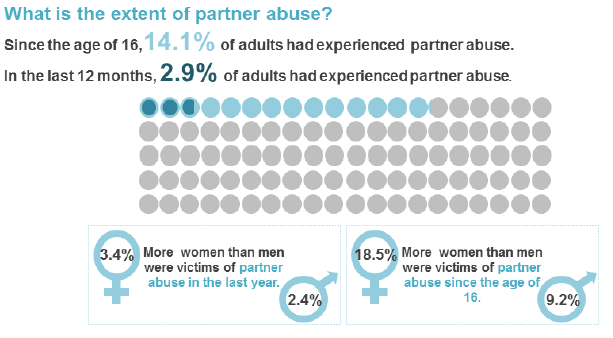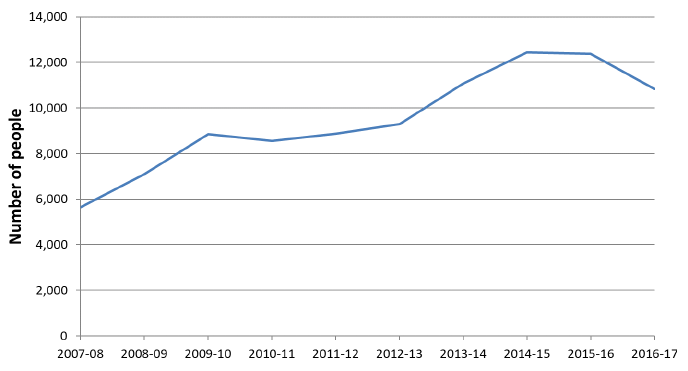Domestic abuse: statistics recorded by the police in Scotland - 2017/18
Characteristics of victims and perpetrators of domestic abuse incidents recorded by the police in Scotland.
This document is part of a collection
4. Putting Domestic Abuse in Context
4.1 There are a number of data sources which collect information on domestic abuse in Scotland.
- The Scottish Crime and Justice Survey (SCJS) provides information on Partner Abuse.
- As detailed in this publication, Police Scotland record the number of incidents reported to them on domestic abuse.
- The Crown Office & Procurator Fiscal Service (COPFS) have information on Procurator Fiscal markings and how many charges are reported to courts
- The Scottish Government publish statistics on proceedings and convictions, which take place in the Scottish courts, through their Criminal Proceedings in Scotland publication.

4.2 The Scottish Crime and Justice Survey (SCJS) is a large-scale survey measuring people’s experience and perceptions of crime in Scotland. The survey is conducted annually and based on a representative sample of adults (aged 16 and over), living in private households in Scotland.
The SCJS also provides results on the prevalence and nature of partner abuse in Scotland. The data on partner abuse is collected through a self-completion module of the survey. The 2014-15 survey, published in May 2016, is the fifth sweep of the SCJS to include a partner abuse questionnaire, with previous data sweeps conducted in 2008-09, 2009-10, 2010-11 and 2012-13.
It should be noted that even though the SCJS has a similar definition of domestic abuse to police recorded incidents, there are several differences that will affect the comparability of the data.
- Most incidents of domestic abuse go unreported to the police for a variety of reasons.
- The 2014/15 SCJS found that a fifth (19.5%) of those who experienced partner abuse in the last 12 months stated that the police came to know about the most recent incident.
- When asked the reasons for not reporting the most recent incident of partner abuse to the police, the most common reasons given were that the abuse was a private, personal or family matter (34.4%), that those involved had dealt with the incident (31.8%), or that the abuse was too trivial/not worth reporting (25.2%). Around one-in-ten (9.3%) said that they did not wish to answer the question, and 11.4% stated “another reason”.
- The SCJS is a sample of those aged 16+ and in private households. For example adults staying in Care Homes or those aged under 16 will not be in the estimates.
- The SCJS is capturing the victim’s experience of partner abuse. Although the survey is self-completion, some respondents may choose not to disclose information on particular incidents.
Results from the 2014-15 Partner Abuse Module:

Between 2008-09 and 2014-15, the overall risk of experiencing any partner abuse in the last 12 months decreased from 4.2% to 2.9%. The risk of partner abuse in the last 12 months did not change between the 2012-13 and 2014-15 survey sweeps. A higher proportion of women than men experienced partner abuse in the last 12 months, at 3.4% and 2.4% respectively.
More detailed information, along with explanatory notes, is available at: http://www.gov.scot/Topics/Statistics/Browse/Crime-Justice/crime-and-justice-survey/publications. Results from the SCJS partner abuse module covering the period 2016/17-2017/18 will be available in early 2019.
4.3 The Crown Office and Procurator Fiscal Service (COPFS) publish management information on the number of charges reported to COPFS and taken forward to the courts with a domestic abuse aggravator attached.
More detailed information, along with explanatory notes, is available at: http://www.crownoffice.gov.uk/publications/statistics.
4.4 The Scottish Government publishes statistics on proceedings and convictions, which take place in the Scottish courts, through their Criminal Proceedings in Scotland publication. These statistics are derived from data held on the Criminal History System (CHS), a central database used for the recording of information on persons accused and/or convicted of committing a criminal act. Aggravator codes can be recorded on the CHS to provide additional information relating to the nature of a charge – one of these aggravator flags is entitled ‘Domestic’ referring to ‘Domestic Abuse’.
Chart 9: People convicted with a Domestic Abuse aggravator recorded against the main charge, Scotland, 2007-08 to 2017-18

Statistics on aggravators have been revised in the 2015-16 publication and now show the number of people convicted with an aggravator recorded, based on the main charge in a proceeding. In previous years aggravator statistics related to all charges included in a proceeding and therefore the revised figures are lower than in previous publications. There were 10,830 convictions where a domestic abuse aggravator was recorded against the main charge, a decrease of 12% from 2014-15 (12,376 convictions). This represents the second consecutive fall following a gradual increase between 2007-08 and 2014-15. The most common conviction with a domestic abuse aggravator in 2017-18 was Breach of the peace etc. (46%) followed by common assault (29%) and crimes against public justice (16%). The longer term increase has been driven by an increase in breach of the peace convictions, particularly offences of “threatening or abusive behaviour” or stalking.
The increase since 2010-11 may also be reflective of a strengthened emphasis on tackling domestic abuse in Scotland by both Police Scotland and the COPFS. The increase does not necessarily mean that domestic abuse is occurring at a greater level than in previous years but may be due, in part, to increases in reporting these types of crimes and improvements in the recording of domestic abuse cases on the CHS.
More detailed information, along with explanatory notes, are available from: http://www.gov.scot/Topics/Statistics/Browse/Crime-Justice/PubCriminalProceedings.
Contact
Email: Mark Bell
There is a problem
Thanks for your feedback